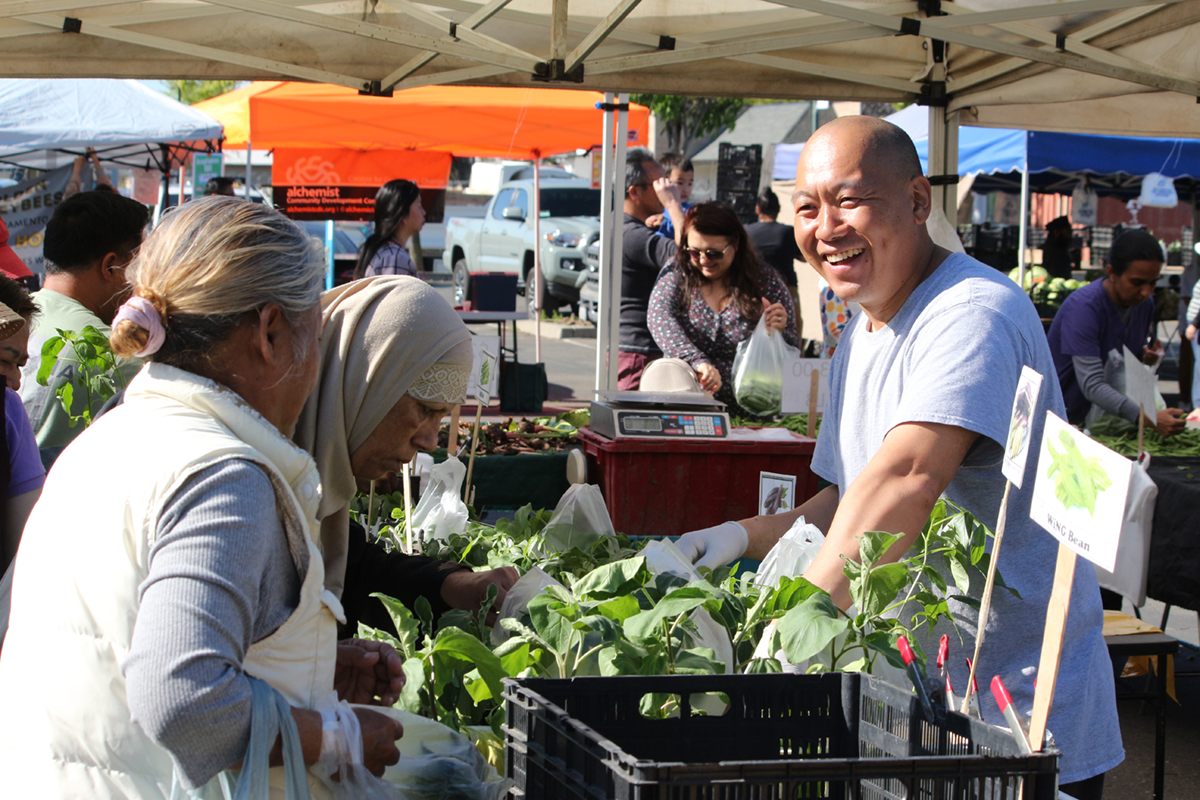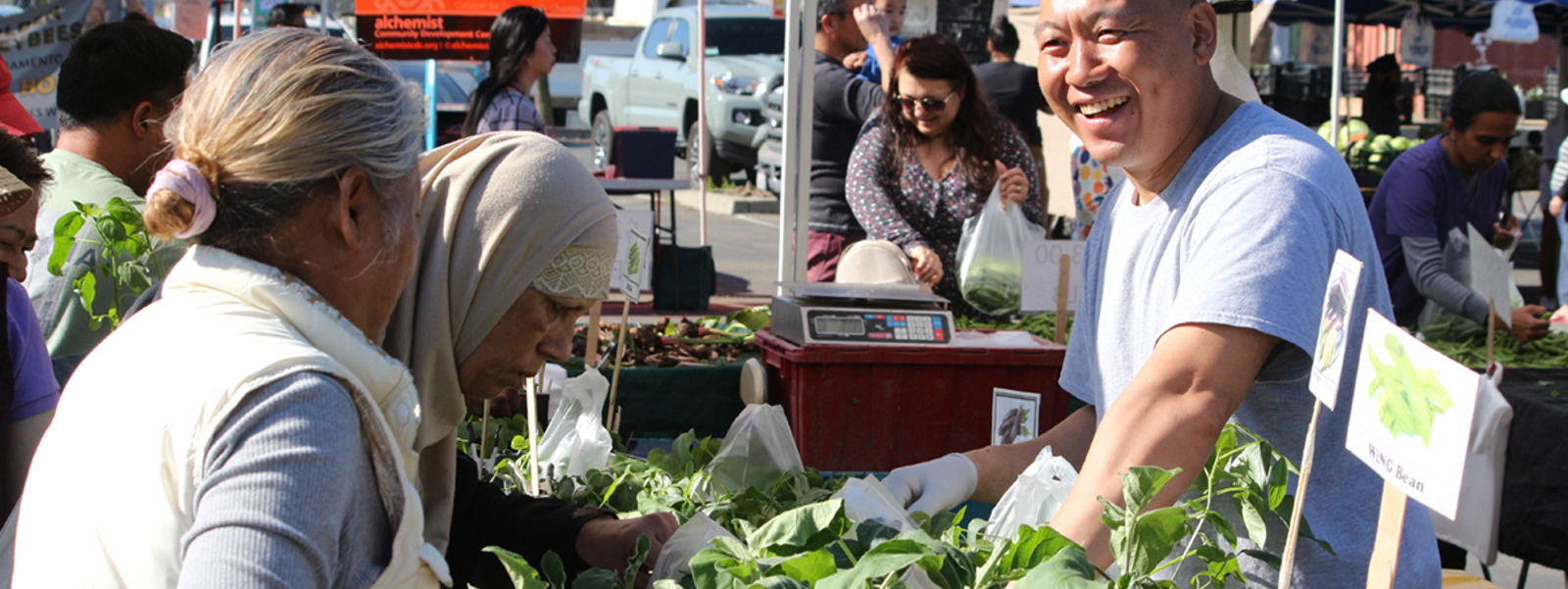Farmers markets fight rain, lighter traffic

San Joaquin County farmer Tony Moua, right, of Averi Moua Farm in Stockton interacts with customers at a weekday farmers market in Sacramento last week. He says cooler weather has delayed his spring crops while the wet ground has prevented him from planting summer vegetables.
Photo/Ching Lee

By Ching Lee
Heavy rainstorms this spring have boosted the state’s water supply for farming, but they have dampened farmers market attendance and crop selection in the immediate term.
While grocery stores are already stocking imported summer fruits and vegetables, farmers market produce remains in transition, with many farms still selling cool-season offerings such as broccoli, cauliflower, hard squash, beets and navel oranges. More fragile crops such as strawberries have taken a beating from the wet weather.
“I think people are tired of the winter crops,” said Uriel Castillo, who was selling for Stockton-based Busalacchi Farms at a weekday farmers market in Sacramento last week. “They want something different.”
He said markets tend to get busier as the weather warms and “the produce starts changing.” The change has been slow, farmers say, as their crops are taking longer to mature due to lack of sun and heat. Saturated grounds have also delayed planting of summer crops.
Castillo said some spring crops are starting to show up, pointing to the asparagus, fava beans and green beans that were new at his booth last week.
Dan Best, coordinator of Certified Farmers Markets of Sacramento, said weather has had “a dramatic impact” on farmers markets, especially on the more popular weekend markets. He noted he had to cancel one this month due to rain, wind and slow crowds.
“If the farmers have problems, we have problems in supply,” he said. “If it rains on a Saturday, it hurts everything because people don’t come out.”
Karen Wetzel Schott, who manages farmers markets in Ventura and Los Angeles counties, said rainy, gloomy weather has resulted in spotty supply.
Some farmers who usually sell year-round have come to markets “only a handful of times since the beginning of the year” because they don’t have enough to sell. Rain-damaged strawberries meant farmers missed out on sales for Valentine’s Day and Easter, “which are huge food holidays for us,” she said.
“We’re shooting for Mother’s Day. That’s our next big flowers and food holiday,” Wetzel Schott said.
Beyond issues with Mother Nature, Best said some farmers markets have not recovered from impacts of the pandemic.
Many Sacramento downtown offices remain closed, with some opening one or two days a week. One market that caters to office workers during the week never reopened, he noted. Another seasonal market “that’s more of a lunch kind of thing, the farmers are doing not very well,” he said.
“I have not seen the crowds increase,” Best said.
One contributing factor for decreased attendance could be the disappearance of brick-and-mortar stores near farmers markets, which benefited from patronage of employees and customers in business and shopping districts, he said. Retailers such as Walmart and Costco have also “stepped up their game” by carrying more fresh fruits and vegetables, Best added.
Kern County farmer Greg Tesch, who has been selling at and managing farmers markets for nearly three decades, agrees.
He said many grocery stores “have done a great job of copying farmers markets” by offering more unique items that used to be available only at farmers markets. The supermarket chain Sprouts Farmers Market even adopted the connotation in its name.
But Tesch said he thinks the decline in farmers market attendance predates the pandemic. He considers the “heyday” of farmers markets to be during the housing boom nearly 20 years ago, when he used to participate in seven to nine markets a week. Now he goes to two.
“I’ve shrunk my farmers market business based on the shrinking clientele,” he said. “I’m doing fewer markets, doing much less business at each market, and my plantings have gone way down.”
After the housing bust in 2008, Tesch said, “I’ve never achieved half of what I used to be able to sell at a farmers market, even with my best crop mix.”
He and Best also agree that farmers markets can’t compete with grocery stores on convenience, especially with some market vendors being cash only. Many small farmers remain reluctant to accept credit cards because they incur extra fees.
However, more markets now do take EBT, or electronic benefit transfer cards, formerly food stamps, which Tesch said has encouraged a “wider diversity” of people to shop at farmers markets.
Despite the “tremendous amount of energy and time” it takes to sell at farmers markets, Tesch said he does it more as a community service, as it allows farmers to provide the public with crops that are picked at peak ripeness, giving people “the best eating experience, and a lot of times that means better nutrition.”
For Tulare County farmer James Birch, purchases from restaurants and chefs have been a major boon to his farmers market business. Some chefs shop directly at the market, while others go through distributors such as Sysco, which he described as one of his best customers.
“They’re not there looking for price either; they’re looking for quality,” he said. “They don’t come (to the market) and say, ‘Oh, can we please get it for wholesale (prices)?’”
Birch sells at the downtown Santa Monica market on Wednesdays and Saturdays. Most of the time, 80% to 90% of his produce has been sold by the time he gets to the market, which serves as a hub for customers to pick up their orders. This system was a huge plus during the pandemic, he noted, and remains a mainstay of the market, which accommodates “lines of big trucks coming to pick up.”
As with any business, location matters, suggested Michi Yasutomi-Ward, who manages five of Orange County Farm Bureau’s nine farmers markets.
She said when she started managing the Tuesday farmers market at Irvine Regional Park 11 years ago, “I didn’t think we were going to make it because we were so far out, like nowhere zone.”
It took seven years before the market started getting more popular, she said, and now it is one of her most successful markets. She said it benefits from the wide variety of activities in and around the park, with a zoo and places for families to hike and ride horses. There’s also a variety of food options to complement the farmer vendors, including people selling mini donuts, smoothies, bento boxes and teriyaki.
Trish Harrison manages the other four farmers markets for the Orange County Farm Bureau, and she described all of them as “very lucrative.”
The one on Saturdays in Irvine is by far her biggest, with 114 vendors and no room for more. She said it helps that Irvine is between Los Angeles and San Diego counties. Farmers from as far away as Fresno sell at the market, which also attracts growers from San Diego, Riverside, San Bernardino and Santa Barbara counties.
Because of the market’s multicultural clientele, vendors are selling crops “that people can’t get anywhere else,” Harrison said. It’s easy to spot food trends there—from kale to dragon fruit to super-hot chilis to different microgreens.
What’s the hot item these days? Specialty mushrooms, which she said are coveted by bodybuilders. “I’ve got it all in my market,” Harrison said.
(Ching Lee is an assistant editor of Ag Alert. She may be contacted at clee@cfbf.com.)




